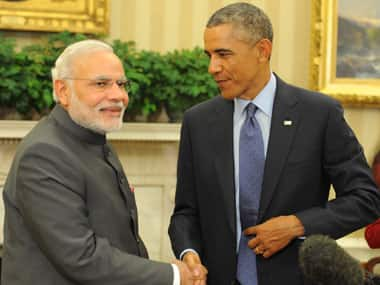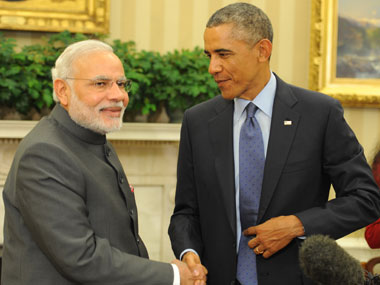For the first time ever, a BJP-led government at the Centre has made public the details of its understanding with the United States on nuclear issues. Details of the understanding reached during President Barack Obama’s India visit last month were released by the Ministry of External Affairs on Sunday in the form of Frequently Asked Questions (FAQs). It is a big development considering that during the second and third terms of the BJP-led Atal Bihari Vajpayee government, the details of several rounds of talks between foreign minister Jaswant Singh and US deputy secretary of state Strobe Talbott were kept under wraps and never released.[caption id=“attachment_2087123” align=“alignleft” width=“380”]  Developing relationship. Image courtesy PIB[/caption] Firstpost is making available hitherto unknown aspects of the protracted and sensitive negotiations the Modi government has held with the Obama administration. On directions of Prime Minister Narendra Modi, the MEA released a set of FAQs describing how India and the US reached an understanding on a range of nuclear issues over five months from September 2014 to January 2015. Significantly, the understanding was thrashed out in three meetings of a Contact Group that included government and commercial stakeholders on both sides. Work began in early September 2014 as part of preparations for PM Modi’s US visit and was concluded just hours before President Obama landed in Delhi on 25 January 2015. An Administrative Arrangement (AA) to implement the 123 Agreement was the first leg of this understanding. The text has been cleared and is likely to be signed shortly. (Emphasis added) Government sources say that the text is consistent with India’s practice and the country’s international obligations. Nuclear material obligated to the US and other civil nuclear cooperation partners such as France will remain under IAEA safeguards as per the provisions of India’s safeguards agreement with the IAEA; there will be no bilateral safeguards. A member of the Contact Group put it thus: “It was a question of convincing each other that our respective systems work and meet our requirements. The US was convinced that the material obligated to it would be handled responsibly and would remain under IAEA safeguards. India was convinced that the AA text conforms to the bilateral agreements with the US, in particular the Arrangements and Procedures on Reprocessing, and its practice of IAEA safeguards.” An Indian official clarified that there will be annual and not six-monthly consultations under the AA and that this is a normal provision, which also reflects the requirements of the 123 Agreement. Thus, while there are Indo-US specificities, the overall template is standard practice. With regard to the much debated law on civil nuclear liability, an understanding was reached in the form of a memorandum that has been exchanged with the US. The FAQs state that there is no proposal to amend the law or the rules notified under the law. Nor has government waived the right of recourse under Section 17 of the law. Instead clarity has been provided to how the right of recourse will operate through the contract between the operator and the supplier and an insurance pool has been created to provide a common ground to the operator and the suppliers to manage their collective and separate financial risks as per the law. While the insurance premium details are being worked out, the FAQs state that the impact on power generation cost will be negligible and the Government’s contribution of Rs 750 crores will taper off much before any foreign reactor comes on stream. There will be three types of insurance products. The operator will buy one to cover his maximum liability under the law while turnkey suppliers like Westinghouse would buy another insurance to cover his risk under the right of recourse, which would move on to the insurance pool by subrogation. Concerns of domestic and foreign suppliers over the broad scope of Section 46 have also been addressed by clarifying that this is standard language in special laws such as the CLND Act to underline that other laws continue to operate in their respective domains. However, the courts cannot read the word ‘supplier’ into the Section since that word was specifically voted out during the adoption of the CLND Bill nor can the notion of domestic jurisdiction be read out of the law since another amendment to add foreign jurisdiction was voted out in the Rajya Sabha. The FAQs also provide details of the compensation that would be available to the victims promptly in case of an accident. Rs 1500 crores would be paid out immediately on behalf of the operator from the insurance pool run by the Indian insurance companies. The Central Government will step in with more money from a Nuclear Liability Fund set up in accordance with the provisions in the CLND Act based on a small levy of up to 5 paise per unit of nuclear energy generated. International funds would be available in addition once India becomes a party to the international Convention on Supplementary Compensation. The policy hurdles now out of the way, attention is likely to shift to commercial negotiations. The government is targeting at least 30,000 MW of nuclear power generation through international collaboration. All these reactors would come with lifetime fuel supply guarantees and would also have significant localization implications. An official said that India hopes to create a Light Water Reactor manufacturing ecosystem through new collaborative models with AREVA of France, Westinghouse of US and Atomstroyexport of Russia to bolster the Make in India programme. The spent fuel from these reactors would also add to India’s reprocessing capacity for the second stage of its 3-stage indigenous programme.
It is a big development considering that during the second and third terms of the BJP-led Atal Bihari Vajpayee government, the details of several rounds of talks between foreign minister Jaswant Singh and US deputy secretary of state Strobe Talbott were kept under wraps and never released.
Advertisement
End of Article
Written by Rajeev Sharma
Consulting Editor, First Post. Strategic analyst. Political commentator. Twitter handle @Kishkindha. see more


)

)
)
)
)
)
)
)
)



